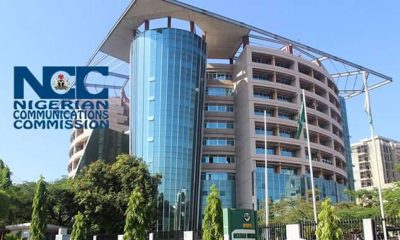Business
Govt bottlenecks still inhibiting agric business– Farmfields CEO

Mr. Zanau Hassan Maikasuwa is the CEO of Farmfields Agro-allied Services, an agro-allied consulting and supply firm located in Jalingo, Taraba State. He is an ardent agricultural expert and a strong believer of improving agricultural methods for an improved and more rewarding agricultural sector in Nigeria. In this interview with BLESSING PETER, he assessed the performance of the President Mahammadu Buhari administration efforts at making agriculture the bedrock of the Nigerian economy. Excerpt:
How would you assess the agricultural sector under the present administration?
The administration has made huge progress in a number of ways that is impacting on agricultural productivity in Nigeria which includes rice production; this administration has introduced the Anchor borrowers program through the CBN to ensure funding for rice growers to increase local production of paddy rice as well as processing of rice in the country.
This effort has led to an increase in local rice production; it has also drastically reduced rice importation in the country. Another area of impact of the rice policy is the job creation aspect, it has massively engage farmers across the various rice producing areas in the country. There is also an increase in investments in rice processing companies which are also employing a lot of labour.
The presidential initiative on fertilizer has succeeded in bringing down the cost of fertilizers as well as increased availability across the country. There is still more to do in order to make fertilizers and farm inputs more available though.
In the area of encouraging local export of our agricultural commodities, the administration has tried in the areas of Yam export initiatives as well as other commodities. These have helped in easing the bottlenecks being experienced in exporting agricultural commodities.
There is still much that needs to be done in the area of accessing funding by smallholder farmers, adequate extension services to rural areas to boost local production etc.
Are you saying the CBN Anchor Borrowers Scheme has been successful so far?
The CBN anchor borrowers program has its pluses as well as minuses. It has succeeded in increasing funding, but whether or not it is a sustainable venture for banks in terms of loan recovery is a different ball game and more need to be done to ensure loans are recovered so that the program can be a success. Another area of minuses is that it does not cover all crops as well as not covering all farming communities in Nigeria.
What are the downsides of the Anchor Borrower Scheme?
One of the challenges that Anchor borrowers program has is the fact that banks were not able to recover all the monies they gave out as loan, this has been a challenge and also made the scheme unsustainable because for banks to be able loan to agriculture, they also should be able to recover the loan at the end of the tenure of the loan.
If banks are unable to recover their loan, then they will not be able to extend these loans, so Anchor borrowers program under the CBN has not practically succeeded in that regard and that has also been a challenge for most banks lending through the anchor borrowers scheme because you know most of these farmers are small holder farmers, some of them do not have bank accounts and the new scheme as introduced is for farmers who have BVN and all that but even at that there is high level of lack of repayment of loans by the farmers and some farmers who receive the loan decide not to pay back, such farmers are being blacklisted and disqualified from further loans so possibly in the future, when such farmers know that they will be blacklisted and will not qualify for further loans, they will pay up.
The second point is the fact that the anchor borrowers program does not cover all states; i.e. not all states are benefiting also it is very few percentage of Nigerian farmers that are benefiting from the anchor borrowers program for example the loan to rice farmers is happening across some certain number of states and the conditions for accessing the anchor borrowers loan can be very tedious and it’s also not an easy one. It does not cover all crops as well so you’ll find out that majority of community where farmers have not benefited from the anchor borrowers program that has been happening and that has been challenge and then if you want to access you’ll have to bring a processor of that commodity that will be able to stand as an anchor and then you have the bank on one side and the suppliers on one.
There’s a whole lot of activity which has made the program so cumbersome and not easily accessible. The fact that it has not covered up to 10% of Nigerian farmers doesn’t make it successful as far as I am concerned.
You mentioned farmers being blacklisted as a means for banks to recover their loans, how feasible is that and do you mean that farmers who don’t have bank accounts can’t access the loan?
Of course, it is feasible, if a farmer is blacklisted, he will not be able to access funds anywhere, from any bank again until he’s able to repay back his loan which means that if a whole community continue to default and are being blacklisted, it means that, that community will lack the necessary funds to expand their businesses and also expand their agriculture, this will instill discipline. It will also enable farmers to know that now banking is a very serious business where you can’t just take loan and walk away without paying.
You also need to remember that these people because of their capacity, they’re very poor and some of them don’t even have assets the banks can rely on to be able to recover their loans but it will instill that discipline and that fear in them to ensure that they pay back. And on the issue of having bank account to access loan, it is not only bank accounts, farmers who even have bank accounts without the BVN will not be able to access the CBN loan or loans from any bank; so you must have bank account and you must have BVN.
The BVN is what will enable any bank to be able to track you anywhere you are doing transaction or you have multiple bank accounts. That is one area the banks are using to be able to mitigate their risks.
Apart from tracking farmers financial transactions through their BVN how else do the banks reduce their risks?
Banks can reduce their risks through effective monitoring, this will also entail that the banks are able to have staff who are dedicated to the farmers, who understand rural farming or rural communities very well, know where these farmers are located or also having offices close to farming communities. These will also aid farmers to be able to effectively pay back their loans. Most commercial banks are always located in the cities and that has always been a big challenge.
So, how could the banks to recover their loans?
For banks to be able to recover loans from farmers, first of all, banks must be able to understand the Nigerian farmers. The largest population of our farmers are rural people, they are people who are mostly illiterates that live in rural areas where there are no banks and there are virtually no social amenities like electricity, good roads, water and the likes so commercial banks must be able to adopt the strategies that works for rural communities especially working as microfinance banks or developing the strategy that microfinance banks use because microfinance banks are able to reach out to rural communities, they have staff who have been trained to be able to reach out to people within that circle. So I think that is one way for the banks to be able to step up.
What impact would the inclusion of microfinance banks and farming cooperatives have on the Anchor Borrowers’ Scheme?
The anchor borrowers program will be more effective if microfinance banks are actively involved because they are the banks who have the direct reach to farmers, who also understand farmers; they also have access to rural communities and can recover loans from rural farmers more effectively than the commercial banks.
What happens in a case where a farmer accesses loan from a bank but meets with disaster such as flooding in the case of crop farmers and animal mortality in the case of livestock farmers? How then can the lending banks get back their money in such situations?
In case of natural disasters: pest and diseases or any outbreak that happens on the farm be it crops or animals, there is what we call agricultural insurance. Before you take any loan, you must get that insurance. No bank gives you loan without insurance because they know of the associated risks. So it is an important tool in agricultural lending.
Farmers need to be aware, already banks are aware of it. Much more our insurance companies need to be serious so as to be able to monitor farmers as well to ensure that they are doing the right thing and also know when they are having problems for them to be able to qualify for the payout or to be fully insured..
How can the anchor borrowers scheme be all inclusive and achieve covering at least up to 50% of Nigerian farmers?
For the anchor borrowers program to cover up to 50% of Nigerian farmers is a huge task, I think if they can even cover 20% they would have even tried. I think the Central Bank need to work out a financing model for small holder farmers in Nigeria. There are examples of agric financing which has worked within this country and I think these models need to be replicated.
We have the Babbangona model; we have input financing models that are working in several communities. These are models that need to be understudied and fine tuned and then escalated or expanded to be able to cover a lot of our communities, that way, I think more farmers will be able to access these finance.
What is the percentage success rate of these example models?
They record minimum of 95% recovery rate.
How has insecurity in the north impacted on the country’s food security?
Insecurity has greatly impacted on various communities along the middle belt region who are major growers of commodities like yam, potatoes, cassava etc. A lot of the farmers are living in Internally Displaced Persons (IDP) camps and can’t access their farms. This means these people will have nothing to survive on for the next year. This has a way of increasing poverty and insecurity in those communities as joblessness is in itself a danger to the society. It will also increase the cost of food and make affordability a serious challenge.
How can this impending danger be tackled?
Well, government has to re-intensify efforts in tackling security challenges especially in rural communities in order to safe guard the lives of our farmers on their farms. Secondly, they should find lasting and amicable solutions to farmers- herders crisis.
What can you say about investments in the agricultural sector?
There are a number of investments especially in rice production and processing, but I cannot say such for other crops yet. The insecurity in the north does not also support investments. More need to be done to attract more investments across the country.
What do you suggest in order to achieve getting more investors?
The government needs to work on making sure investors find it easy to set up their businesses and recover their investments with ease. Therefore, bottlenecks need to be resolved, affordable financing with lower interest rate is another thing that will help. Then government needs to be more responsive in attracting investments by making government agencies more responsive.
Can you buttress on these bottlenecks and what is the current interest rate range for agricultural loans?
Government bottlenecks are a lot, such as getting certificate of occupancy (C of O), business registration, NAFDAC, tax issues etc. Interest rates are higher than 25%
Recently the CBN promised to reduce Cash Reserve Ratio (CRR) for banks that extend credits to the agric and manufacturing sectors. How far can this motivate lenders to give loans to the agric sector with the risks associated with that sector in the country?
Regarding the CBN cash reserve ratio, reducing the cash reserve ratio for commercial banks to lend to agricultural sector and the real sector, I think this is a welcome development; it will enable banks to increase their lending to the agricultural sector.
One of the strategy CBN is trying to implement is to ensure the banks are very comfortable for them to lend and it is an incentive on the sides of the bank to ensure that banks do lend or increase lending to the agricultural sector because if you look at it, high interest rate has been the major concern but with this CRR I think it will make the banks to lower their interest rate especially to the agricultural sector because having a high interest rate of 25% and above doesn’t make sense for an agric business in Nigeria considering the numerous risks that businesses are being faced with.
So I believe that CBN will be able to monitor the banks well to ensure that they stick to this commitment and the banks also continue to lend. There are a lot of agric businesses that are doing well who deserve such and those who have not shown capacity, the banks should find a way of dealing with such so as not to jeopardize the entire scheme of lending to the real sector.
The non-oil sector contributed significantly to 1.5% of the economy recorded in Q2 of 2018. What does this mean to the country?
When we say non-oil sector is contributing 1.5% to the GDP, it means a lot; it means that there is growth in the non-oil sector. The non-oil sector are other sectors which includes agriculture, services, manufacturing and the likes, now it means that they are able to employ more people, increase their production, activity is happening and there is a lot of money going into the economy.
It means the real sector is very active, in essence, it means there’s increase jobs in the sector and a lot of circulation of money which helps the economy to be buoyant and also ease out the stress of people, people are able to meet their daily needs of paying for rent, school fees, clothing, increase consumer spending as well as food and many other things and that is what the economy needs. The real sector is what actually moves the economy. The oil sector contributes the largest chunk to the GDP but in terms of impact on jobs it is low because they employ very low number of people in comparison to what the real sector employs.
What percentage of the population does the agricultural sector employ?
The GDP figures tell us that agriculture contributes about 23-25%, there are also other statistics that say about 70million Nigerians are involved in agriculture even though they may not be directly involved in farming. For the farming population, there was a figure from the ministry of Agriculture that puts about 12million Nigerians actively involved in farming, and you know agriculture involves a large value chain so there are a lot of activities involved so we may have up to 70 million people or even more who are involved in agriculture.
Some others say about 70% of Nigerians are involved in one form of agriculture or the other, they are either directly involved in farming or in the value chain activities such as processing, transportation, supply of farm inputs, marketing and the likes.










